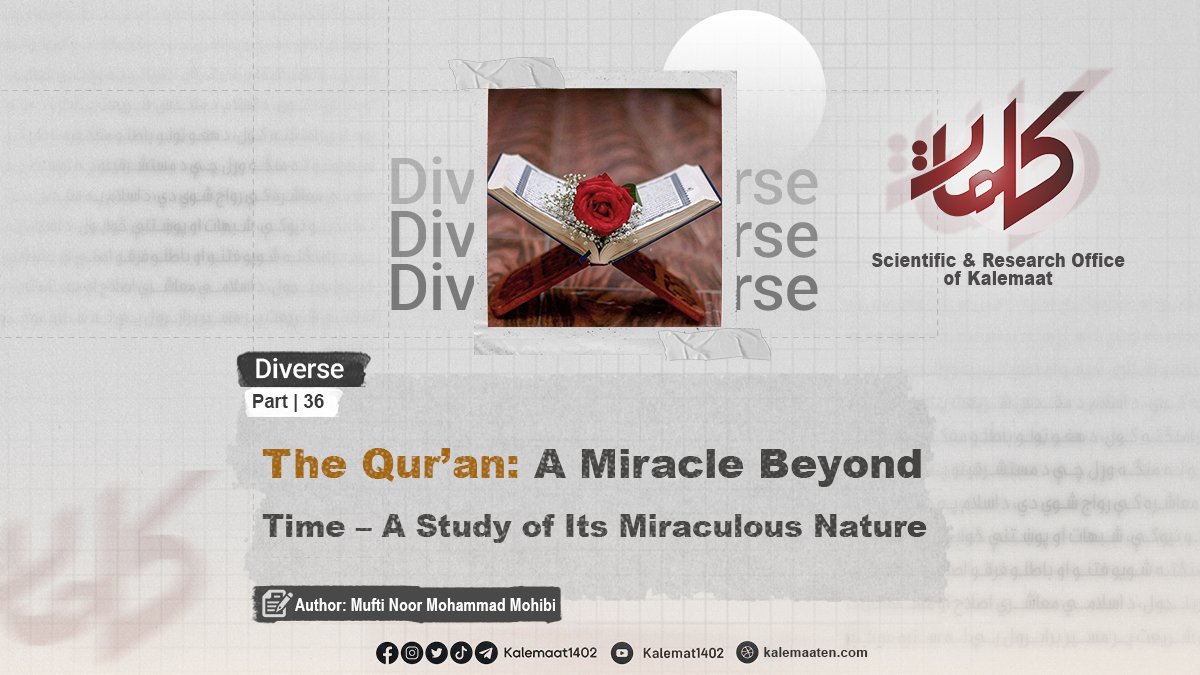Author: Mufti Noor Mohammad Mohibi
The Quran: A Miracle Beyond Time- A Study of Its Miraculous Nature (Part 36)
The Masterpiece of Creation in the Human Auditory System
Within the human body lie signs and wonders, each a clear proof of the wisdom and greatness of the One Creator. Among these marvels is the tympanic membrane (eardrum)—a structure extremely delicate yet possessing an extraordinarily complex and vital function.
Structure and Location of the Tympanic Membrane
The tympanic membrane is a thin layer, no more than 0.5 millimeters thick, with a diameter of approximately 9 millimeters—less than one centimeter. In terms of tissue, it is simultaneously tough like steel, flexible like plastic, and alive and active in transmitting sound waves. The smallest injury to this membrane may lead to complete loss of hearing.[1]
To protect this sensitive structure, Allah the Almighty has placed it at the end of the external auditory canal—a curved passage, narrower than a person’s little finger—so as to prevent foreign objects from entering and causing harm.
Connection to the Middle Ear and Pressure Balance
Among the signs of Divine wisdom is the connection between the middle ear and the throat through the Eustachian tube. This canal balances the pressure on both sides of the tympanic membrane. If external pressure increases, internal pressure (from the mouth and throat) counters it, preventing the membrane from rupturing. This system also protects the ear against extremely loud sounds.
The Four Auditory Ossicles
The tympanic membrane is connected to four tiny bones (the malleus, incus, stapes, and the stapedial muscle). Their total weight does not exceed 55 milligrams, and their combined length is about 19 millimeters. These ossicles play crucial roles:
-
Amplifying weak sounds up to 20 times
-
Reducing the intensity of loud and harmful sounds
This dual function within a highly precise physio-neural system demonstrates humanity’s inability to create anything comparable, and is a clear sign of the Creator’s power.
Neural Protective Frameworks
For sounds that exceed the permissible limit (over 100 decibels), the ear’s nervous system intervenes. The delicate muscles attached to the stapes, through the facial nerve, are activated to reduce the ear’s sensitivity and thus prevent damage. Even certain facial expressions (when failing to hear or understand speech) can affect auditory sensitivity.
Pathway of Sound Transmission
Sound is essentially a vibration transmitted as a mechanical wave through a physical medium (liquid, solid, or gas). It first reaches the tympanic membrane through the air, then passes via the ossicles to the middle ear, and finally enters the inner ear, where it is transmitted with great precision through fluid to the auditory cells.
The Power of Distinguishing Melody from Noise[2]
The human ear contains around 25,000 auditory cells responsible for analyzing and distinguishing sounds. Scientists still do not fully understand how the ear differentiates between pleasant melody and disturbing noise. Why does the sound of breaking glass irritate us, while the sound of a waterfall soothes us? This remains one of the profound mysteries of hearing.
The Wonder of Auditory Memory
A human being can store the voices of thousands of people in memory. Over a telephone call, without seeing the other person, one can recognize them solely by the tone of their voice. This extraordinary sensitivity of hearing and the recording of sounds in memory is one of the unmatched wonders of creation.
The Superiority of Hearing over Sight
In the Holy Qur’an, in most verses, the word as-sam‘ (hearing) precedes al-basr (sight). Scholars explain this precedence as follows:
-
Hearing becomes functional in the womb by the 26th week of pregnancy, whereas sight is not fully operational until several months after birth.
-
A human can hear from six different directions, even in complete darkness, whereas vision is limited to what lies ahead.
-
A deaf person is usually mute and struggles in learning, while a blind person can become highly knowledgeable and distinguished.
The Qur’anic Precedence of “Hearing” over “Sight”
In 17 verses of the Qur’an, the word sam‘ precedes basr, including:
(إِنَّا خَلَقۡنَا ٱلۡإِنسَٰنَ مِن نُّطۡفَةٍ أَمۡشَاجٖ نَّبۡتَلِيهِ فَجَعَلۡنَٰهُ سَمِيعَۢا بَصِيرًا) [Al-Insan: 2] Translation: “Indeed, We created man from a drop of mixed fluid in order to test him, and We made him hearing and seeing (that is, endowed with reason and knowledge).”
This precedence is due to the importance of hearing in comprehension, as well as its earlier development in the stages of fetal growth. In some verses, however, sight precedes hearing, such as: (رَبَّنَا أَبْصَرْنَا وَسَمِعْنَا فَارْجِعْنَا نَعْمَلْ صَالِحاً) [As-Sajdah: 12]
Translation: “Our Lord! We have seen and heard (what we once pretended to be blind and deaf to). So send us back, that we may do righteous deeds.”
Here, the precedence of sight is related to the speed of light (300,000 km/s) compared to the speed of sound (330 m/s).
Conclusion
In summary, the tympanic membrane, despite its small size and delicate structure, plays the primary role in hearing and perceiving sound. This organ is not only a sign of the miracle of creation but also a striking example of how modern science aligns with the Qur’an: (إِنَّ السَّمْعَ وَالْبَصَرَ وَالْفُؤَادَ كُلُّ أُو۟لَٰٓئِكَ كَانَ عَنْهُ مَسْـُٔولًا) [Al-Isra: 36] Translation: “Indeed, the hearing, the sight, and the heart—each of these [faculties] will be questioned about.”
(وَفِيٓ أَنفُسِكُمۡۚ أَفَلَا تُبۡصِرُونَ) [Adh-Dhariyat: 21] Translation: “And in your own selves [are signs of Allah’s power and wisdom]. Will you not then see?”[3]
Continues…
Previous Part / Next Part
References:
([1]) the narrow duct that connects the middle ear to the pharynx.
([2]) Noise: unwanted and annoying sound or signal.
([3]) Encyclopaedia of Al-Ijaz al-Alami fi Qur’an and Sunnah, vol. 1, pp. 131-134.



